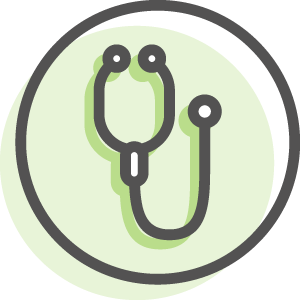
The Complete Guide to BHRT for Women

Many women experience a hormonal imbalance.
Often, these imbalances can be caused by perimenopause and menopause – but women of any age can experience hormonal deficiencies for a variety of reasons, including pregnancy, chronic medical conditions, and certain medications.
Bioidentical Hormone Replacement Therapy, or BHRT, can help address these hormonal deficiencies in women.
Throughout this guide, we will provide a comprehensive overview of BHRT, hormonal imbalance symptoms, available treatment options, frequently asked questions, and more.
What is BHRT for Women?
BHRT is a form of hormone restoration that uses hormones which are identical in structure to those found in the body. BHRT is available in a variety of options, which are often called delivery systems. These include include injections, topical creams and gels, patches, pellets and more.
How is BHRT different from earlier types of hormone restoration?
Previous forms of Hormone Replacement Therapy (HRT) utilized hormones that came from animals. These hormones were similar in structure and function to human hormones, but not an exact match.
Bioidentical hormones are structurally identical and typically lead to fewer side effects than earlier forms of hormones derived from animals.
Does BHRT work?
BHRT is often very effective in helping to optimize hormone levels and ease symptoms of hormone imbalance. Because every person is different, a BHRT protocol should be individualized based on comprehensive lab results, symptoms, and goals for treatment.
BHRT is typically an ongoing treatment, meaning that you will likely continue supplementing hormones indefinitely to keep your levels optimized. There is currently no effective treatment that can fully restart your body’s natural hormone production, which is why ongoing replacement is necessary.
What Causes Hormonal Imbalances in Women?
The most common cause of hormonal balance in women is perimenopause – when your body is transitioning into menopause – and menopause itself.
Menopause occurs when a woman’s body stops producing Progesterone and Estrogen, the two main female hormones. During this time, women also stop experiencing menstruation. Menopause usually starts when a woman is in her 40s to 50s, although perimenopause can begin years before and cause similar symptoms.
You can typically tell you’ve entered menopause if you haven’t experienced a period for a full twelve months. Perimenopause is a little more difficult to identify and is usually diagnosable through symptoms, which are very similar to the symptoms of menopause.
Perimenopause can last for years and greatly affect your quality of life, even if you have not yet entered menopause. If you are experiencing symptoms consistent with perimenopause, you can take steps now to reduce those symptoms and regain your drive and passion for life.
What are the symptoms of menopause?
The symptoms of menopause and perimenopause include:
- Night sweat and hot flashes
- No period (menopause) or irregular periods (perimenopause)
- Trouble sleeping or not sleeping as deeply as you used to
- Mood swings, anxiety, depression and/or trouble regulating emotions
- Mental fog and forgetfulness
- Vaginal dryness and/or pain during intercourse
- A decrease in sexual desire (libido)
- Weight gain in hard-to-lose areas like the abdomen
- Changes in body composition, including a higher body fat percentage
- Dry skin and dry, thinning hair
- Painful or achy joints
- A more difficult time getting in or staying in shape
You may show some or all these symptoms. You can also experience these symptoms even if you have not crossed the threshold into menopause. Perimenopause can last for years and cause a decreased quality of life similar to that of menopause.
Other Causes of Hormonal Imbalance in Women
While perimenopause and menopause are the most common causes for hormonal imbalance in women, they are not the only causes. Women of all ages can experience a hormonal imbalance that leads to life-interrupting symptoms.
Alternative causes include:
- Certain medications, including birth control
- Chronic health conditions like diabetes, hypothyroidism (underactive thyroid) and certain genetic conditions
- Medical procedures like a hysterectomy (removal of the uterus) and/or oophorectomy (removal of one or both ovaries)
- Pregnancy and breastfeeding
- Premature menopause
- Polycystic Ovarian Syndrome (PCOS) and other ovarian conditions
- Chemotherapy and cancer
Because hormonal imbalance is most often related to menopause, many women do not realize they are experiencing a deficiency, and their symptoms unfortunately go untreated. These symptoms are typically the same ones listed for menopause, especially issues with sex drive and physical intimacy.
Even if you are not of menopause age, you could still be experiencing a hormonal balance – and BHRT may still be able to help you.
What Hormones Do Women Have?
To understand hormonal imbalance in women, it’s important to know what sex hormones the female body produces.
Sex hormones in women include:
- Estrogen, which is produced by the ovaries and in much smaller amounts form the adrenal glands and fat cells. Estrogen is produced in three different forms: Estradiol, Estrone, and Estriol. BHRT often replaces Estrogen in the form of Estradiol, which is the most utilized form within the body. BHRT may also utilize Estriol, or a combination of Estradiol and Estriol which is called Bi-Estrogen.
- Progesterone, which is produced by the ovaries and responsible for ovulation and menstruation. Progesterone prepares the uterus for pregnancy (leading to menstruation if pregnancy does not occur) along with other functions.
- Testosterone, which is produced by the ovaries and adrenal glands. Many people don’t realize that the female body also produces Testosterone, though in lower amounts than men. Testosterone plays an important role in female reproductive health and sexual desire.
- DHEA (dehydroepiandrosterone), which is an androgen that is key to the creation of Estrogen and Testosterone.
- Pregnenolone, which is the precursor hormone to many other hormones, including Testosterone Estrogen, Progesterone, and Cortisol.
BHRT typically includes a combination of these hormones, which interact and impact each other. BHRT may also include other hormones that are not related to sex hormones. For example, those suffering from an underactive thyroid (hypothyroidism) may take T3 or T4 thyroid hormone.
Diagnosing a Hormonal Imbalance
We’ve talked about the symptoms and causes of female hormonal imbalance, and what hormones women have – but how do we diagnose a deficiency?
Different providers have different approaches to diagnosing and treating hormonal imbalance in women. At Defy Medical, we require comprehensive lab work so we can have a complete view of your overall health. We also consult with patients one-on-one for up to an hour to understand their symptoms and experiences. These two approaches together help us understand what’s happening in your body.
The Eve Questionnaire
The Eve Questionnaire is a tool to evaluate whether you may be experiencing hormone deficiency symptoms.
- Do you have hot flashes?
- Do you have a lack of energy, or have your energy levels decreased?
- Do you have restless sleep or sleep disturbances?
- Are you falling asleep after dinner?
- Have you noticed a decreased enjoyment of life?
- Are you moody or easily irritated?
- Do you have difficulty concentrating, or have short-term memory loss?
- Have you noticed muscle loss?
- Do you have excess body fat?
- Have you experienced low libido and/or pain during intercourse?
Take the Eve Questionnaire now.
Note: The Eve Questionnaire is meant to provide guidance and is not intended to be medical advice. Blood testing and consulting with a knowledgeable provider are required to diagnose hormone deficiency.
Comprehensive Lab Testing
In addition to examining your symptoms, our providers will go over your lab results to receive a full picture of your health and to accurately diagnose the cause of your condition. Tests in the required panel include:
Complete Blood Count (CBC)
A CBC panel measures the different components of the blood, including white blood cells, red blood cells, and platelets. This type of test can help diagnose conditions like anemia, inflammation, infection, and cancer.
Comprehensive Metabolic Panel
A Comprehensive Metabolic Panel helps doctors understand how the many systems throughout your body are functioning. This kind of panel shows measures your glucose levels, kidney function, liver function and fluid balance.
Lipid Panel
A Lipid Panel measures the fatty substances in the blood. These include cholesterol – specifically HDL, the “good” cholesterol” and LDL, the “bad” cholesterol. This test shows the ratio between HDL and LDL and can help your doctor understand your overall health.
Testosterone Free and Total
This test measures the total Testosterone in the blood, which includes bound and unbound Testosterone. It also specifically measures the amount of unbound, or free, Testosterone. Measuring both gives your provider an understanding of not only the total amount Testosterone in your bloodstream, but how much of it can be utilized by the body.
Estradiol
This test measures your blood serum levels for Estradiol, the most common form of Estrogen. Estrogen is one of the three main sex hormones that can cause a hormone deficiency in women. This test helps your provider understand your starting point for Estrogen.
DHEA-S
This test measures the Dehydroepiandrosterone (DHEA) in your blood. DHEA is an androgen (male sex hormone) that contributes to the production of Estrogen in women and Testosterone in men. Hormone balance is a complex system that depends on many variables, including DHEA. Measuring your DHEA levels can give your provider an understanding of how your hormones interact with each other.
TSH
Thyroid Stimulating Hormone (TSH) encourages the release of thyroid hormones T3 and T4. These hormones are crucial to maintaining the metabolism and overall function of the body. Testing for TSH can help identify a potential thyroid disorder.
Thyroid hormone deficiencies can cause similar symptoms to sex hormone deficiencies, so this test is an important screening tool to make sure your protocol treats the correct condition.
FSH
Follicle Stimulating Hormone (FSH) is found in men and women and performs different functions for both. In women, FSH regulates the menstrual cycle and supports the creation of eggs in the ovaries.
Testing FSH levels can give insight into whether a woman has entered menopause, because FSH levels change during this time. This test can also provide insight into infertility and the menstrual phases.
Progesterone
Progesterone is the female sex hormone responsible for maintaining the menstrual cycle and ovulation, among other functions. Because of its role, Progesterone is often a facet in hormone deficiency. Testing your Progesterone levels allows your provider to understand if Progesterone is contributing to your deficiency symptoms.
IGF-1
Insulin-Like Growth Factor (IGF-1) is involved in the production of Human Growth Hormone (hGH), an important hormone in development, wound healing, recovery, and more. Testing for IGF-1 can indicate your hGH levels as well as your overall pituitary health.
What are your BHRT Options?
Let’s say you order the comprehensive testing and consult with a provider, and your bloodwork combined with your symptoms shows that you have a hormone deficiency. What do you do next? And what are the BHRT options available to you?
BHRT protocols for women typically include a combination of the following hormones:
- Estrogens (Estradiol, Estriol, or a combination of Estradiol and Estriol called Bi-Estrogen)
- Progesterone
- Testosterone
- Pregnenolone
- DHEA
These hormones are available in many forms, including creams and patches, injections, implantable pellets, suppositories, and more.
Now we’ll go over the BHRT options available to you.
BHRT Injections
Estrogen, Progesterone, and Testosterone are available as subcutaneous and intramuscular injections. These injections are typically given weekly, and sometimes more frequently depending on your protocol. Injections are widely considered the most effective way to deliver hormone doses, and they allow for the greatest control of levels.
Estrogen is available as its most bioavailable, or useable form, Estradiol. It is suspended in two different esters:
- Cypionate
- Valerate
Esters are compounds bound to the Estrogen that give it a longer lifetime in the blood. With esters, the hormone gets into the blood slowly over time, creating more even hormone levels (and thus reducing symptoms from hormone level changes).
With Cypionate, the Estrogen is typically released into the blood over the course of 7-8 days. Valerate has a half-life of 4-5 days and can stay active for one to four weeks, depending on dosage and other factors.
Testosterone is available in multiple esters as well, the most common being Cypionate and Propionate.
The right ester for you depends on your response to your treatment, your starting levels, and your overall goals. Your provider will work with you to find the best treatment methods for you.
Progesterone typically does not include an ester and is often suspended in a grapeseed carrier oil. Progesterone is usually injected daily, though protocols vary by patient.
Estrogen, Testosterone, and Progesterone injections are available via compounding pharmacies, which can tailor the dosage and the ester (if applicable) to your needs for a customized treatment. They are also available as commercial prescriptions with set dosages.
Intramuscular and Subcutaneous Injections
Depending on your protocol and dosage level, your injections may be intramuscular (IM) or subcutaneous (SQ).
Intramuscular injections are injected into the muscle. They penetrate deeper and are more quickly absorbed into the bloodstream. Subcutaneous injections go into the fatty layer of the skin and are absorbed over a longer period of time. The needle is smaller on sub-q injections, which may be preferable for patients seeking a more comfortable injection method.
Intramuscular injections are typically given at the following sites:
- The upper thigh
- The shoulder
- The hip
Subcutaneous injections are typically given at the following sites:
- The stomach
- The fatty tissue of the thigh
- The glutes
- The upper arm
BHRT Injections: Benefits and Drawbacks
If you’re considering hormone injections, you may wonder about the pros and cons of this delivery system. Here’s a quick breakdown.
The benefits of hormone injections include:
- They offer quick and effective replenishment of hormone levels. Injections deliver hormones directly to the bloodstream with no hormone dosage lost. This makes injections an ideal delivery system for many patients on a BHRT protocol.
- The immediacy of the delivery also allows for adjustments to be made quickly based on your body’s response, so you can reach the right, or optimal, hormone levels for your body.
The drawbacks of hormone injections include:
- While BHRT injections are preferred by many patients for their effective results, some patients wish to avoid giving themselves weekly or bi-weekly injections.
- Injections can cause hormone levels to peak when the hormone reaches the bloodstream after injection, and to hit lows right before the next injection. That’s why our Defy Medical providers work with each patient to develop an injection schedule that minimizes this variation in hormone levels. It’s also why different esters may be used for a timed release, depending on the hormone
Topical BHRT
BHRT is also available via topical application, which means it can be applied directly to the skin with lotions, creams, and gels.
With topical BHRT, a small amount of product is applied to the skin, where it absorbs slowly over time (usually around 24 hours). From the skin, the hormone or hormones absorb into the bloodstream, delivering a steady dose over time.
A topical BHRT protocol typically includes Progesterone, Estrogen in the form of Bi-Estrogen (Estradiol and Estriol), and Testosterone. Your provider will work with you one-on-one and create an individualized protocol based on your unique hormone levels, symptoms, and goals for treatment.
Topical BHRT includes a carrier base, which is the lotion, cream, or gel that allows it to be applied to the skin for absorption.
There are different types of bases, and the right one for you can depend on a number of factors. The types of hormone bases include:
- Heavy cream base, which is designed to deliver multiple hormones into the bloodstream via topical application. This base is best for a BHRT protocol that includes more than one hormone.
- Light cream base, which is a thinner, oil-in-water mixture that also helps moisturize the skin.
- Versabase®, which is a lotion that offers quick absorption with cosmetic skin moisturizing properties.
- Alcohol-based gel, which absorbs the quickest. This type of base offers fast absorption, which minimizes potential transfer of the product onto objects or other people. A potential drawback is that the alcohol can dry out the skin.
These bases are available from compounding pharmacies and can be formulated with an individualized combination of hormones to suit your unique protocol.
Other topical applications exist from brand-name products, including topical patches and different types of lotions and creams.
How does Topical BHRT Work?
Topical BHRT is typically applied every 24 hours, though your protocol may vary. Common application sites for women include:
- The abdomen
- The inner thighs
- Inter-vaginally
We typically advise female patients to avoid application sites near breast tissue, which is why the arms, shoulders, and chest are not usually recommended. You may be instructed to rotate your application site to avoid skin irritation, especially if you have sensitive skin and/or are using an alcohol-based gel, which may cause dryness.
Once applied, the hormones will absorb into the fatty layer of the skin (the subcutaneous layer) and into the bloodstream over time. With topical application, not all of the hormone reaches the bloodstream, which is why the dosages may be higher than other forms.
Topical BHRT: Pros and Cons
Wondering if topical BHRT is right for you? Here’s a quick breakdown of the benefits and potential drawbacks.
The benefits of topical BHRT include:
- It’s an effective and simple option for patients who want to avoid weekly or bi-weekly injections.
- It provides a continuous dose of hormones over time to keep hormone levels steady and avoid peaks and lows, which could cause mood swings and side effects.
- It can be made into a convenient combination treatment with multiple hormones in one simple daily application.
The drawbacks include:
- Because the hormones are applied to the skin, it’s possible to transfer the medication onto other objects and people. Parents with small children should be especially cautious of transference. This is why more private application sites, like the inner thighs and inter-vaginally, are considered better options. This is also why a fast-drying gel base may be preferable.
- Since only around 5% to 20% of the hormone is absorbed from the carrier base into the bloodstream, it is less effective than other delivery systems like injections.
BHRT Pellet Therapy
With this type of therapy, a small hormone pellet or pellets are implanted under the skin. These pellets deliver a steady dose of hormones a little at a time over the course of three to four months. Once the pellet or pellets run their course, a new one or ones are implanted to continue treatment.
Defy Medical performs the simple pellet insertion procedure at our clinic in Tampa, FL. These pellets are typically about the size of a grain of rice and the insertion is relatively quick and painless, taking about 15 minutes. Prior to the procedure, your provider will numb the area to ensure you are comfortable.
On average, a BHRT Pellet Therapy patient will have about three to four implant procedures per year, though this number can vary due to Defy Medical’s individualized patient plans. This makes it a much simpler option for patients who wish to avoid daily or weekly self-administered delivery systems.
Pellet Therapy also works well for patients who tend to forget medications and those who struggle with giving themselves injections or applying topical BHRT daily.
Pellets come in various dosages of Testosterone and Estradiol, two of the main hormones that commonly cause hormone deficiencies. Depending on your blood test results and goals, your doctor may recommend other supplemental treatments alongside BHRT Pellet Therapy.
BHRT Pellet Therapy: Pros and Cons
When considering BHRT Pellet Therapy, it’s important to weigh the benefits as well as the potential downsides.
The advantages of BHRT Pellet Therapy include:
- Pellet Therapy offers a simpler process that includes three to four (sometimes more, depending on the patient) insertions per year rather than daily or weekly self-administered applications.
- It’s a more “hands-off” approach to hormone restoration that can work well for patients who struggle with daily medications or who don’t have a lifestyle that works with more involved BHRT delivery systems. Patients typically choose Pellet Therapy over other options for this reason.
The downsides of BHRT Pellet Therapy include:
- Pellet Therapy protocols can take longer to optimize because bodies metabolize hormones differently, and pellets offer one application over a longer period of time. You’ll work closely with your Defy Medical provider, who will monitor your progress, symptoms, and symptom relief to make sure you’re on the right dosage and on the right implantation schedule. It may take time and adjustments to find the correct protocol that optimizes your hormones effectively.
- Because there is so much time between dosages, Pellet Therapy offers less control of hormone levels and less maneuverability to make adjustments in your protocol.
HRT Vaginal Suppositories
BHRT is also available in the form of vaginal suppositories. The most common hormones used in a BHRT vaginal suppository protocol include:
- Estrogen in the form of Estradiol
- Progesterone
- DHEA
- A combination of DHEA and Estriol
Suppositories come in the form of capsules, which are inserted vaginally to deliver a steady dose of hormone over time. Dosages vary by hormone and based on patient needs, and so do application times and number of applications per week or month.
Benefits of BHRT Vaginal Suppositories
Suppositories are typically recommended if you are experiencing sensations like vaginal pain and dryness, pain during intercourse, and other vaginal discomfort symptoms related to hormone deficiency.
Suppositories can provide topical relief as well as the standard hormone dosage, which can help ease discomfort symptoms while treating a hormone deficiency. Suppositories are also neater than standard inter-vaginal topical application.
Certain suppositories, such as DHEA and a combination of DHEA/estriol, are specifically for the treatment of dyspareunia, or painful intercourse caused by vaginal atrophy as a result of menopause. If you are experiencing this condition, BHRT suppositories may be the best option.
Since suppositories are inserted into the vagina, transference of the hormone is much less likely compared to other forms of hormone delivery, like topical application.
Drawbacks of BHRT Vaginal Suppositories
Suppositories are less customizable than other BHRT options, like topical BHRT or BHRT injections. If you require a protocol with multiple hormones in varying dosages, suppositories may not be a good fit for you.
However, if your symptoms are related to a single hormone deficiency such as Estrogen, Progesterone, or DHEA, vaginal suppositories may be a good option.
If one of your major symptoms is vaginal atrophy or pain during intercourse, BHRT suppositories may be able to help address this symptom to make intimacy more enjoyable and pleasurable.
BHRT Capsules
BHRT is also available for women in the form of oral capsules. Most hormones used in a BHRT protocol are available as capsules, including:
- Estrogen in the form of Estradiol, Estriol, or Bi-Estrogen (a combination of Estradiol and Estriol)
- Progesterone
- DHEA
- Pregnenolone
- Compounded hormone combinations
Your protocol may include one or multiple hormones depending on your lab results, symptoms, and overall needs. The capsules come in many dosage forms to offer an individualized approach and to help find the right hormone restoration program to optimize your hormone levels.
The Benefits of BHRT Capsules
BHRT capsules offer a customizable approach to hormone replacement therapy. Because oral medications are more common, many patients are more comfortable taking oral BHRT than options like self-administered injections, topical application, or vaginal suppositories.
BHRT capsules also allow for customization with many different hormones and dosage forms, which makes them effective for creating an individualized protocol.
The Downsides of BHRT Capsules
While capsules are a familiar dosage form for many patients, they have a common problem: loss of medication to the digestive system.
As with most other pills and oral medications, only a portion of the hormone medication makes it to the bloodstream from the digestive tract. This can make it less effective than delivery systems like injections, where all of the hormone reaches the bloodstream where it can be used by the body.
Combination and Supplemental Therapies
Because optimal hormone levels vary by patient, protocols should be individualized. This means your protocol may include different types of hormones at different dosages or separate delivery systems.
At Defy Medical, you will have the opportunity to speak one-on-one with your provider about your needs and lifestyle, so you can work together to create a protocol that works for you.
For example, if you have a busy schedule, you may prefer one convenient daily topical application compounded with all the hormones you need. Or you may prefer multiple injections depending on how your protocol makes you feel and how your hormone levels respond. Or perhaps you’ll favor a mostly injection-based protocol with a DHEA vaginal suppository to help with vaginal dryness and pain, as another example.
Defy Medical offers an individualized approach because we know each patient needs different things to feel their best. Your provider will make sure you understand the options available to you and will provide suggestions based on your symptoms and goals for treatment (you don’t have to decide all on your own).
Your protocol may also include supplemental medications and treatments that can help with sexual dysfunction, libido, nutrition, thyroid disease, and more. Because all of these things together may be causing you to feel a decline in your overall wellness and zest for life.
Other services we offer include:
- Sexual Health treatments to improve libido and ease discomfort.
- Thyroid Hormone Replacement Therapy to treat thyroid disease.
- Peptide Therapy to optimize Human Growth Hormone levels.
- Nutritional Supplementation, both oral capsules and injectable nutrition as well as IV infusions at our Tampa clinic.
- Physician-Guided Fat Loss plans with prescription medication as appropriate to help with fat loss and improving body composition.
- Prescription Skincare and Aesthetics to help with anti-aging, hyperpigmentation, acne, and other skin concerns.
- Virtual Primary Care to treat common health concerns via convenient telemedicine appointments.
BHRT Frequently Asked Questions
Now you have a comprehensive background on hormone deficiencies, why they occur, and your BHRT options for treating them. Here are some common frequently asked questions we receive from patients and those who are interested in learning more about BHRT.
What Should I Expect When Starting BHRT?
Before you start a BHRT program at Defy Medical, you’ll first get comprehensive testing to accurately identify your hormone deficiency or deficiencies.
Then you’ll consult with our experienced providers via telemedicine for up to an hour. During this time, your provider will do a deep dive of your test results, go over your BHRT options plus any supplemental treatments that may be necessary, and answer questions. This is a great time to talk with your provider about any concerns you have and to come prepared with any questions.
Together, you’ll come up with a protocol based on your needs, lab test results, goals for treatment, and lifestyle factors. Once your consultation ends, our Patient Support team will assist you with ordering your prescribed medications via our convenient Patient Portal, and your medications will be delivered straight to your door.
During the first few weeks of treatment, you may experience some minor side effects as your body adjusts to your new medication. This is normal since most medications have short-term side effects as your body becomes acclimated. Side effects may include shifts in mood, tenderness at the application or injection site (depending on method of delivery), headaches, breast tenderness, and water retention. After a few weeks, these side effects should subside.
As your body adjusts to your BHRT protocol, some hormone deficiency symptoms may ease quickly. Within a couple of weeks, you may begin to feel more energy, steadier sleep, stabilized moods, and relief from hot flashes and night sweats.
Other changes like improved body composition, increased sex drive, relief from sexual dysfunction, prolonged high energy levels, and an overall zest for life take about eight to ten weeks to begin appearing.
You’ll have a follow-up consult and testing three months after your first consult to check in with your provider. You may require adjustments to your protocol to optimize your levels. This is a great time to let your provider know how you’ve been feeling, if you are still experiencing any symptoms, and how your protocol has been working for you.
You will continue to follow up with your Defy Medical provider every six months to check in and make adjustments, so you stay optimized and feeling great. Since bodies and hormone levels change over time, it’s important to continue monitoring and adjusting your protocol so you continue experiencing the full benefits of BHRT.
How Long Do You Have to Take Hormone Replacement Therapy?
BHRT is an ongoing treatment. You experience hormone imbalance symptoms because your body has stopped producing hormones or produces them at insufficient amounts. There are currently no treatments that can encourage the body to permanently produce more hormones, so BHRT replenishes the missing levels to provide symptom relief.
To continue elevating your hormone levels so that you feel better, you need to continue your BHRT protocol. If you stop BHRT, you will return to the lowered hormone levels you experienced before, which will lead to a return of the life-disrupting symptoms that caused you to seek treatment in the first place.
How Quickly Does Hormone Replacement Therapy Work?
The answer is: it depends.
The goal of BHRT is to optimize hormone levels, so how quickly it works varies by patient. It takes time for medications to build up in the body and create an effect.
For BHRT, some patients report feeling positive changes within a few weeks, which can include improved moods, a better quality of sleep, higher energy levels, and relief from hot flash attacks.
In general, most of the long-lasting benefits of BHRT take about 8 to 10 weeks to fully manifest. These include increased libido, reduced sexual discomfort or pain during intercourse, improvement in vaginal dryness, stabilized moods, an easier time maintaining a healthy body composition and building muscle, and an overall passion for life that may have been missing before.
Consistency and optimization are key with BHRT, as well. It’s important to stick closely to your BHRT program, take your doses as instructed at the same times and days, and to continue with your follow-up consultations and lab work. Your provider will make adjustments as needed to help optimize your protocol for best results.
We don’t just want your BHRT protocol to work as quickly as possible – we want it to make you feel happier and healthier in the long-term.
Is BHRT covered by insurance?
BHRT is sometimes covered by insurance through a Primary Care physician or traditional doctor, but not usually.
Unfortunately, it is an often-misunderstood treatment and many providers do not stay current on the latest protocols and best practices. Insurance companies also do not typically cover all that is required to help you feel your best, and brand-name prescriptions usually don’t offer the variation in dosages and delivery systems needed to create the best plan for you.
Defy Medical frequently treats patients who have tried BHRT care through traditional medical routes and who were left unsatisfied with the level of care they received. We have helped more than 15,000 patients with individualized wellness plans so they could pursue happier, healthier lives.
Defy Medical is a concierge clinic, which means we do not accept insurance. Instead, we offer consistent and affordable pricing to our patients with access to value-pricing for comprehensive lab work and prescription medications – with no insurance-related billing surprises.
Can You Have a Period While on Hormone Replacement Therapy?
Menopausal women who start a BHRT protocol will not begin having regular cycles again. A woman is considered to be in menopause if she has gone at least 12 months with no period. Menopausal women are typically prescribed a frequent dose of Progesterone to keep the uterus from growing a lining which would need to be shed through menstrual bleeding.
It is possible for menopausal women to experience spotting while they adjust to their protocols and as their provider finds the right dosage of hormones. It takes a careful balance of Estrogen and Progesterone to relieve hormone imbalance symptoms while avoiding the buildup of tissues in the uterus that causes menstruation. This spotting is typically nothing to worry about and will clear up as patients reach hormone optimization.
Perimenopausal women who still experience periods but who also have hormone imbalance symptoms will continue to have periods. These periods may become more regular and predictable as a result of balanced hormone levels. Because changes in Estrogen during perimenopause can lead to more difficult periods, BHRT may make menstruation easier.
Are Birth Control Pills the Same Thing as Hormone Replacement Therapy?
No, birth control is not considered BHRT. Birth control won’t balance hormone levels, and BHRT won’t protect against pregnancy.
Both treatments use female hormones, but the goals are very different. Birth control aims to limit ovulation and reduce the chances of pregnancy, plus makes cycles more regular and manageable. Birth control’s hormone dosages are designed for this purpose, and for women with active cycles who have not entered menopause. BHRT is designed to provide exogenous (from outside the body) hormone dosages to replenish hormone levels for women whose bodies no longer secrete enough hormones.
BHRT is often prescribed to menopausal women who don’t actively menstruate. However, it can be prescribed to perimenopausal women with hormone imbalance who still need protection from pregnancy. If you are looking into BHRT but still have birth control needs, speak to your provider about a plan to address both needs.
Can Hormone Replacement Therapy Cause Hair Loss?
Hair loss is often a symptom of hormone deficiency. A decline in the female hormones Estrogen and Progesterone can cause hair to become brittle, grow in thinner, and fall out more quickly.
Many women notice increased hair loss and thinning when they reach menopause age. Replenishing hormone levels and balancing hormones can treat this symptom and lead to thicker hair with less noticeable hair loss.
So, it’s unlikely that BHRT would cause hair loss unless your protocol isn’t individualized enough, which could worsen an imbalance between female hormones and androgens and lead to hair loss and thinning. That’s why routine follow-up consultations and comprehensive lab work are key to a successful BHRT protocol that delivers the right dosages for you.
If you are prone to androgenic alopecia, or a genetic sensitivity to the androgenic hormone Dihydrotestosterone (DHT), you may experience hair loss and thinning once you optimize your hormone levels. This is not caused by the BHRT itself but instead by the genetic hair loss condition; balanced hormone levels just make the symptoms more obvious.
Defy Medical offers hair loss and thinning therapies and prescription medications that can help with this condition (also called female pattern baldness).
Can BHRT Cause Weight Gain?
Many women hesitate to begin BHRT treatment because they think it causes weight gain. In actuality, hormone imbalance can lead to changes in body composition and fat gain, specifically around hard-to-lose areas like the stomach.
Hormones are responsible for many things throughout the body, including regulating body composition. Androgens like Testosterone (which women’s bodies produce as well as men’s) also contribute to muscle growth and overall physical fitness.
When these levels decrease, it can cause unwanted fat gain. What’s worse, hormone imbalance can make weight more difficult to lose.
Have you tried to lose weight but found that no matter how much you diet and exercise, you can’t get shed the pounds? You also may find strategies that worked when you were younger are no longer effective. For many patients, this comes down to a hormone imbalance.
Working with an experienced provider to optimize your hormones can help you get your body back to performing at an optimal level. Then you can pair BHRT with diet, exercise, and a healthy lifestyle to reach your ideal fitness level.
In this way, hormone restoration can help you get where you want to be.
Defy Medical: Your Women’s Health Experts
Now that you have a foundation of knowledge on BHRT, it’s time to take your next step.
Defy Medical has been offering hormone restoration and integrative wellness therapies for more than a decade via convenient telehealth. Our care team is up to date on the latest advancements in hormone restoration and has worked with thousands of patients to help them rediscover their best selves.
With Defy Medical, you access:

Expert Care
Our providers specialize in Women’s Health and use the latest advancements in BHRT.

Convenient Telemedicine
Save time with virtual consultations with experienced HRT providers.

Individualized Care Plans
We go deeper to get to the root causes and create a protocol as unique as you are.

No Subscriptions or Contracts
You control your schedule and cost decisions, and only pay for what you need.

Extended 1-Hour Consults
You can ask questions, discuss your most pressing symptoms, and be heard by your provider.

Regular Follow-Up for Optimization
We don’t leave you on your own. Tracking your progress is key to optimizing hormone levels over time.

Access to Easy Pharmacy Ordering
Conveniently order prescriptions, supplements, and supplies through our online patient portal for direct-to-door delivery.

A Variety of Health Services
We also offer sexual health treatments, injectable nutrition, Primary Care, and more.
Begin Your Care Today
It’s easy to get started. Just provide your information, and a Patient Advocate will reach out to you.
* denotes a required field.